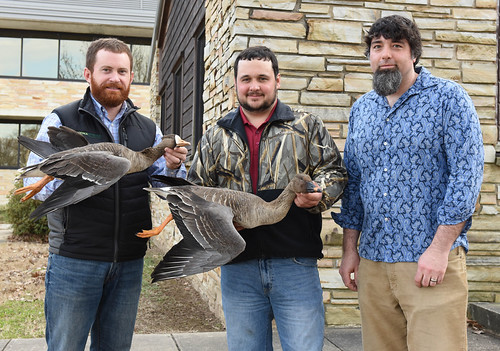Rare bird shows up in goose hunters’ harvest
May 18, 2018
By Mary Hightower
U of A System Division of Agriculture
Fast facts
- Errant goose winds up in flock of white-fronted geese in Arkansas
- Goose’s identity confirmed by DNA testing
(650 words)
(Newsrooms: with art at https://flic.kr/s/aHsmjqCDcj)
Download Word version.
MONTICELLO, Ark. – When Hunter Stafford and Chase Milligan examined their take following some January goose hunting in Lincoln County, they noticed something wasn’t quite right with one of the birds.
The two had been hunting for white-fronted geese, better known as specklebellies in Lincoln County near Dumas. Their harvest for that day included a bird that looked similar to a specklebelly but had an unusually dark face and lacked the black marling that specklebellies have on their chests.

For identification, the goose was taken to said Douglas Osborne, associate professor with the Arkansas Forest Resources Center and the School of Forestry and Natural Resources at the University of Arkansas at Monticello, and a waterfowl researcher.
The lab measured of body size, weight, and gender of the goose, along with noting its coloring. From that information, Osborne and his lab determined from body size and coloration that the rare goose was likely a subspecies of a taiga or tundra bean goose.
To confirm this, genetic tissue and feather samples were collected from the specimen and sent to the United States Geological Survey genetics laboratory in Anchorage, Alaska, for mitochondrial DNA sequencing. The genetic sequence of Stafford and Milligan’s prize goose was compared to a database of known bean geese collected at breeding and wintering locations from across the world.
“The rare goose was determined by genetics to be a 100 percent match of the tundra bean goose subspecies Anser serrirostris that was sampled on Lake Kejonuma, Japan,” Osborne said. “The Arkansas specimen was also a 99.1-99.5 percent match for the same subspecies collected in the Russian Arctic during the breeding season.
The bean goose subspecies is frequently observed in Alaska during winter, and evidence suggests that this goose originated in the Russian Arctic and ended up in Arkansas as she mixed in with a flock of Alaska nesting white-fronted geese that commonly winter in the Delta region of Arkansas.
“This is the first ever record of a tundra bean goose in Arkansas,” Osborne said. “This rare encounter will be preserved by a local taxidermist and will likely be a conversation piece in the hunting lodge for many years to come.”
The Arkansas Forest Resources Center, a University of Arkansas System Center of Excellence, and the School of Forestry and Natural Resources bring together interdisciplinary expertise through a partnership between the University of Arkansas System Division of Agriculture and the University of Arkansas at Monticello. The Center and School are headquartered at the University of Arkansas at Monticello campus, but their programs range statewide.
“This is another example of the strength we have in natural resources research,” said Phil Tappe, director of the Arkansas Forest Resources Center, for the University of Arkansas System Division of Agriculture. “We are not only working to educate the next generation of natural resources professionals, but also improving this generation’s knowledge base.”
For more information, contact the center and school at (870) 460-1052.
About the Division of Agriculture
The University of Arkansas System Division of Agriculture’s mission is to strengthen agriculture, communities, and families by connecting trusted research to the adoption of best practices. Through the Agricultural Experiment Station and the Cooperative Extension Service, the Division of Agriculture conducts research and extension work within the nation’s historic land grant education system.
The Division of Agriculture is one of 20 entities within the University of Arkansas System. It has offices in all 75 counties in Arkansas and faculty on five system campuses.
Pursuant to 7 CFR § 15.3, the University of Arkansas System Division of Agriculture offers all its Extension and Research programs and services (including employment) without regard to race, color, sex, national origin, religion, age, disability, marital or veteran status, genetic information, sexual preference, pregnancy or any other legally protected status, and is an equal opportunity institution.
# # #
Media Contact: Mary Hightower
Dir. of Communication Services
U of A System Division of Agriculture
Cooperative Extension Service
(501) 671-2126
mhightower@uada.edu